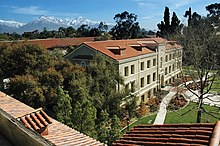
Liberal arts colleges in the United States are undergraduate institutions of higher education in the United States that focus on a liberal arts education. The Encyclopædia Britannica Concise defines liberal arts as a "college or university curriculum aimed at imparting general knowledge and developing general intellectual capacities, in contrast to a professional, vocational, or technical curriculum".[1] Generally, a full-time, four-year course of study at a liberal arts college leads students to earning the Bachelor of Arts or the Bachelor of Science.
These schools are American institutions of higher education which have traditionally emphasized interactive instruction (although research is still a component of these institutions) at the undergraduate level. While there is no nationwide legal standard in the United States, the term "university" is primarily used to designate graduate education and research institutions, and is reserved for doctorate-granting institutions,[2] and some US states, such as Massachusetts, will only grant a school "university status" if it offers graduate programs in multiple disciplines.[3]
These colleges also encourage a high level of student-teacher interaction at the center of which are classes taught by full-time faculty. They are known for being residential and may have smaller enrollment, class sizes, and student-teacher ratios than universities.[4]
- ^ "Liberal Arts: Encyclopædia Britannica Concise". Encyclopædia Britannica. Archived from the original on 2007-09-06. Retrieved 2007-07-08.
- ^ U.S. Department of State: Types of Institutions Archived 2009-06-25 at the Wayback Machine
- ^ Massachusetts Board of Education: Degree-granting regulations for independent institutions of higher education "A university must meet the requirements of a four-year or senior college, and must provide graduate programs in four or more distinct professional fields of study. A university must clearly identify graduate studies as a distinct element within its organization, and must provide the additional faculty, facilities, and resources necessary to support sound graduate programs."
- ^ Conflicted: Faculty and Online Education, 2012 Survey Download. Babson.qualtrics.com. Retrieved on 2013-08-02.